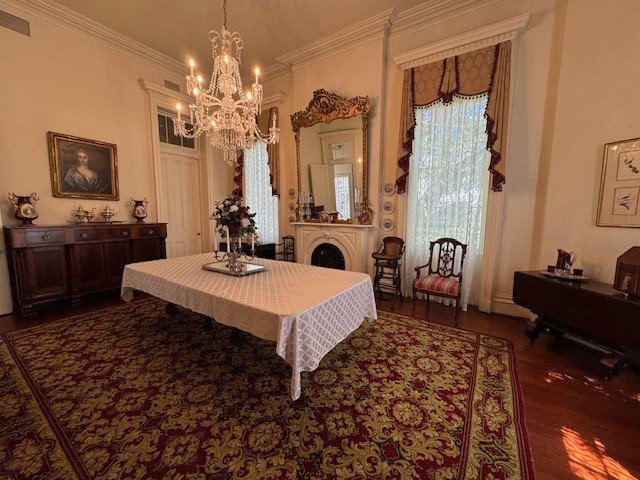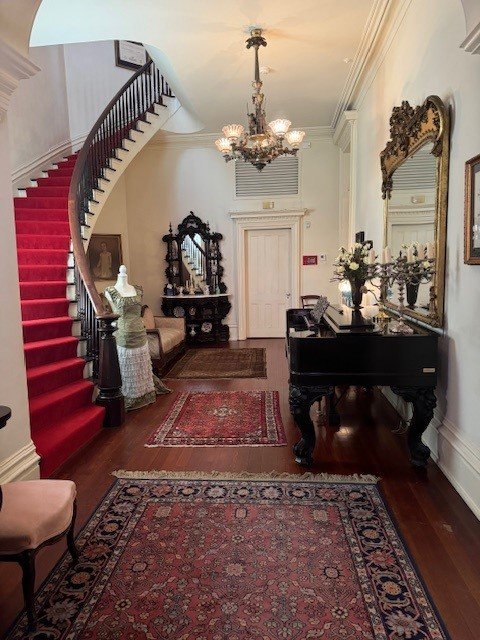
The Richards DAR House: An Historic and Architectural Gem
By: Diane Cashen, Associate ASID
The Richards DAR House, situated in the heart of Mobile, Alabama, stands as an exquisite testament to the Italianate architectural style that flourished in the mid-19th century. This movement drew its inspiration from the villas of the Italian countryside, characterized by their romantic and classical elements. Constructed in 1860, on the eve of the Civil War, for Charles G. Richards, a prominent steamboat captain, this historic residence embodies the elegance and grandeur of the antebellum South. The house reflects the prosperity and social ambitions of the Southern elite during a period of economic growth fueled by agriculture and trade. Mobile, a vital port city, was a bustling hub of commerce, and the Richards were well-positioned within this affluent society. The house remained in the family until 1946. It was donated to the city of Mobile in 1972 whereupon the DAR undertook the task of restoring, preserving and maintaining the property, offering guided tours and special events that bring the history of the house to life. Some key features of the Italianate style visible in the Richards DAR House exterior include:
- A balanced and symmetrical façade with evenly spaced windows and a central entrance. This sense of proportion is a hallmark of the Italianate style emphasizing harmony and order.
- The tall and narrow windows, capped with pedimented lintels, are designed to maximize natural light and ventilation. These windows are complemented by heavy wooden shutters adding both function and aesthetic appeal.
- Decorative brackets support the wide overhanging eaves of the roof while intricate cornices add a layer of detailed ornamentation. These elements enhance the visual complexity of the house’s exterior.
- A prominent cupola crowns the house, providing a panoramic view of the surrounding area and serving as a distinctive architectural feature. The cupola not only adds to the home’s aesthetic appeal but also adds ventilation.
- The house is adorned with beautiful wrought iron detailing including a four-seasons themed fence and balcony railings. This elaborate lace ironwork is both decorative and functional, contributing to the home’s overall elegance. Stepping inside the Richards DAR House, visitors are transported to a bygone era of opulence and refinement. The interior is a showcase of period-specific design and furnishings with each room reflecting the tastes and sensibilities of the mid-19th century Southern aristocracy.
- The entry hall features a sweeping cantilevered staircase adorned with a richly carved banister. This architectural focal point exemplifies the craftsmanship and attention to detail characteristic of the era. Additionally, there are stunning red bohemian glass sidelights and a transom surrounding the entrance door that Captain Richards specifically requested.
- The double parlors are designed for entertaining with high ceilings, elaborate plaster moldings and Carrera marble fireplaces. These rooms are furnished with period-appropriate pieces including ornate sofas, chairs and tables. The light fixtures are extraordinary Cornelius and Baker gasoliers.
- The formal dining room is a testament to the social customs of the time where elaborate dinners were a central aspect of Southern hospitality. The room features a long dining table surrounded by intricately carved chairs and sideboards. A one-of-a-kind Baccarat crystal chandelier hangs overhead.
- Throughout the house, one can find a collection of decorative arts, including fine china, silverware and artwork. These items reflect the wealth and cultured tastes of the Richards family.
The Richards DAR House in Mobile, Alabama is a historic and architectural treasure that offers a rare glimpse into the opulent lifestyle of the mid-19th century Southern elite. Its Italianate design, rich historical context and meticulously preserved interiors make it a must-visit destination for history enthusiasts and architectural aficionados alike. As a beacon of Mobile’s cultural heritage, the Richards DAR House continues to captivate and inspire, preserving the grandeur of the past for future generations.



